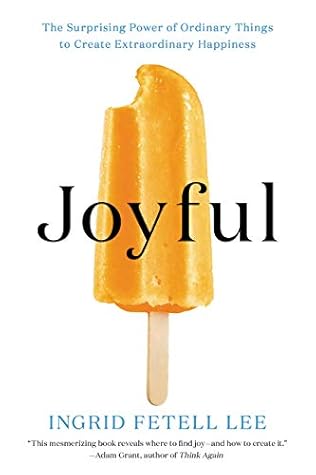More on this book
Community
Kindle Notes & Highlights
Read between
June 10 - July 1, 2019
when psychologists use the word “joy,” they mean an intense, momentary experience of positive emotion, one that can be recognized by certain telltale signs: smiling, laughing, and a feeling of wanting to jump up and down. While contentment is curled up on the sofa, and bliss is lost in tranquil meditation, joy is skipping, jiving, twirling, giggling. It is a uniquely exuberant emotion, a high-energy form of happiness.
Research suggests that color vision provided such an advantage that our ancestors’ brains evolved a reduced capacity for processing smells in order to allow for an increase in the handling of visual information.
Matisse’s light, bright palette makes an ideal choice for color inspiration, but other artists I often look at include Helen Frankenthaler, Sonia Delaunay, Pierre Bonnard, and, of course, David Hockney.
In A Pattern Language, a landmark collection of observations on the ways that people use space, architect Christopher Alexander and his colleagues note that the single most important fact about a building is this: “People use open space if it is sunny, and do not use it if it isn’t, in all but desert climates.” In a study of a residential street in Berkeley, Alexander found that residents on the north side of the street didn’t use their backyards. Instead, they sat in the small front yards next to the sidewalk while the backyards collected junk.
old incandescent light bulbs all used to give off the same color of light. “When you would screw in a light bulb that you bought at the supermarket,” says Shaver, “you knew that it was always going to burn at a color temperature of twenty-seven hundred degrees Kelvin, which is warm and very flattering to the skin.”
Arakawa and Gins believed that the dull comfort of modern buildings lulls our bodies into a stupor that hastens our demise. In their view, our flat floors and white walls numb our senses and our muscles, leading them to atrophy. To combat this problem, they advanced a provocative theory they called reversible destiny, which states that people can prevent aging and thwart death by living in a stimulating environment that challenges their bodies on a regular basis.
Minimalists tout the idea that nature builds with perfect thrift, when in fact the evidence of her extravagance is everywhere. In what economical world does a fruit fly perform dances or a moose carry a coat rack on its head?
Frances Kuo and William Sullivan, the founders of the Landscape and Human Health Lab at the University of Illinois, have found significant correlations between a lack of green space and violence among residents in large housing projects in Chicago. In a notable study, they examined police crime reports for ninety-eight buildings in the Ida B. Wells housing project, finding that buildings with more surrounding vegetation had 50 percent fewer crimes than those with minimal greenery. A similar effect has been observed in prisons, where inmates displayed fewer aggressive tendencies after watching
...more
In 1930, the economist John Maynard Keynes predicted that advances in technology and productivity would allow people in developed nations to work as few as fifteen hours a week.
I stumbled on a blog called Things Organized Neatly. Just as the name suggests, it’s a compendium of objects arranged in trim layouts, as if a fanatic house cleaner has sorted and straightened small piles of miscellany around the globe. There were fall leaves arranged in a colorful gradient, feathers lined up by size, and seashells organized by type. There were offbeat selections, like a layout of tiny utensils—forks and knives, ladles and trowels—from Barbie’s various Dreamhouses, and a grid of ninety toast slices progressing from lightest in one corner to darkest in the other. Some were
...more
I found a kindred spirit in Cathleen McCandless, a no-nonsense feng shui practitioner whose book, Feng Shui That Makes Sense, debunks many of the myths around the discipline’s more mystical promises.
Knolling is a system of placing objects, usually tools, at right angles to one another on a work surface. It originated in Frank Gehry’s furniture workshop in the late 1980s and was popularized by the artist Tom Sachs.
“The need to play is in us,” he said after we’d gotten settled, “and if we don’t do it, we’re in trouble.” He came to this conclusion via an unlikely route. Years ago, he had been tasked with studying convicted murderers in the Texas prison system, in an effort to understand whether there were factors that could make a person susceptible to violent behavior. He and his team took comprehensive inventories of the criminals’ lives, conducting detailed interviews, consulting their friends and families, and comparing them with a well-matched noncriminal control population. After sifting through all
...more


